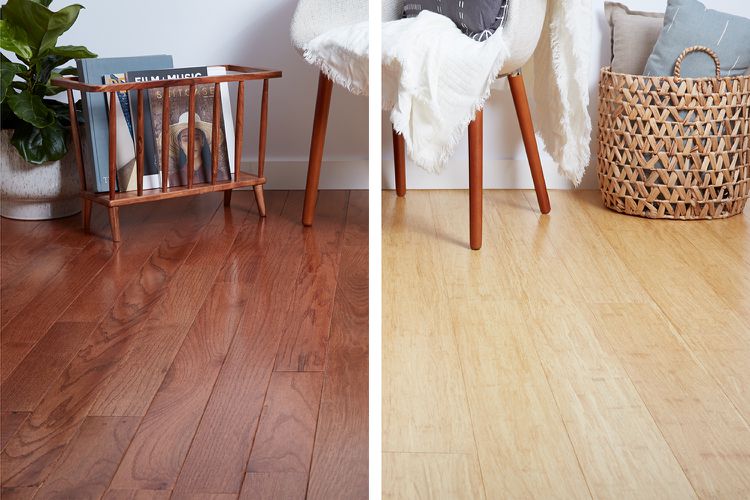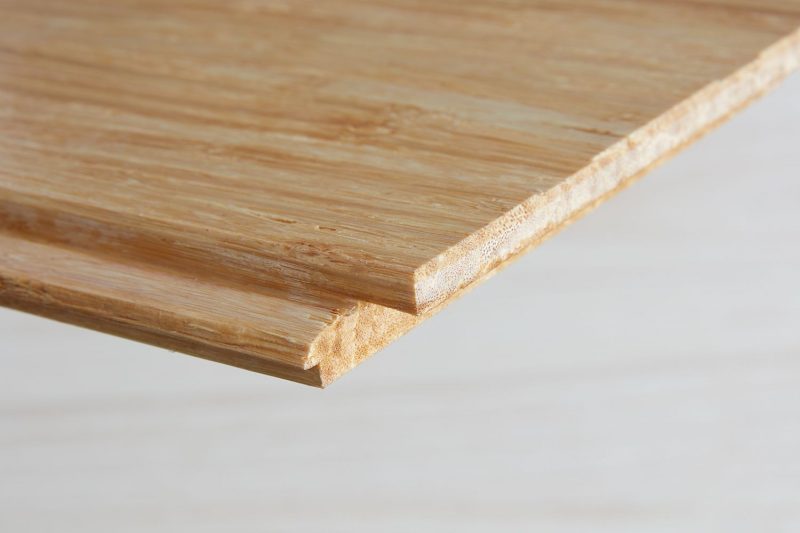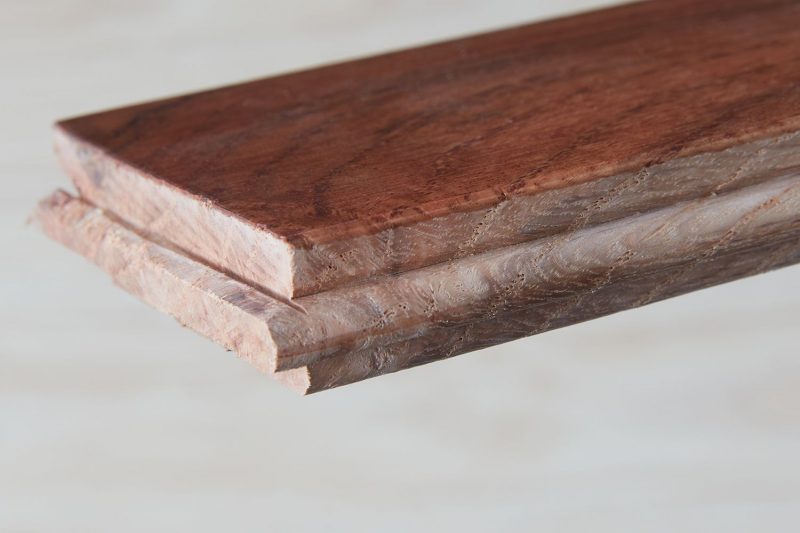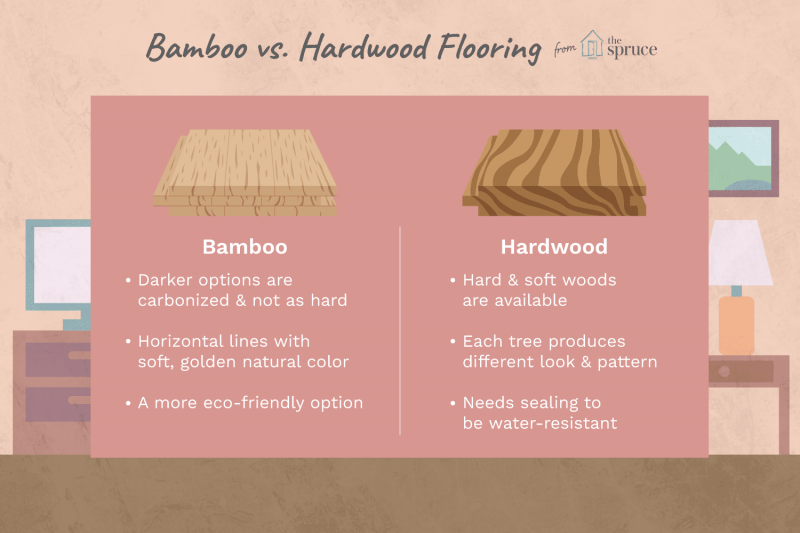
Bamboo flooring may initially appear to be just another type of hardwood flooring. In reality, it is frequently categorized alongside solid hardwood flooring. Both bamboo and hardwood share a comparable aesthetic and texture, and they come in options such as 3/4-inch-thick solid planks as well as engineered varieties, where a high-quality natural veneer is bonded to synthetic core layers. However, despite these resemblances, there are significant distinctions that differentiate these two flooring options.
Contents
Bamboo is not classified as wood.
While often categorized alongside hardwood flooring, bamboo is technically a type of grass, not a wood. This fast-growing plant, indigenous to tropical areas with significant rainfall, develops at a much quicker rate than hardwood and possesses a distinct cellular makeup. One might assume that bamboo flooring is resistant to water, but that is a misconception. Unsealed bamboo can suffer discoloration and damage from water exposure, much like hardwood.

Bamboo can occasionally be tougher than traditional hardwood.
The designation hardwood does not necessarily mean that a wood type is exceptionally hard. In a technical sense, it pertains to wood derived from trees that reproduce through angiosperm seeds, which are seeds encased in some type of ovum or fruit. This classification encompasses a variety of well-known species, including oak, maple, cherry, hickory, and walnut, among others. In contrast, the other primary classification is softwoods, which originate from gymnosperm seeds—seeds that are not covered by an ovum or fruit. This category primarily includes coniferous trees that produce seed cones, where the seeds are fully exposed.
However, when assessing various wood types for their true resistance to impacts or scratches, hardwoods do not consistently outperform all softwoods in terms of hardness. The Janka Hardness Test is a standard method for evaluating wood, which entails pressing a steel ball into the wood and gauging the depth of the resulting indentation. Results from the Janka Hardness Test reveal that certain hardwoods can be softer than various softwoods, and in some cases, even softer than bamboo.
Among the frequently utilized hardwoods for flooring and carpentry, the hardness ratings are as follows:
- Red walnut and Brazilian teak: ranging from 2,500 to 3,500.
- Hard maple: 1,450 units
- Red Oak: 1,220 units
- Cherry: 950 units
- Poplar: 540
- Aspen: 350 units.
Nonetheless, certain softwoods can be tougher than certain hardwoodsfor instance, Eastern red cedar has a hardness rating of 900, while Douglas fir has a rating of 660.
In its natural form, bamboo generally has a Janka hardness rating between 1,300 and 1,400, making it tougher than most oak floors and similar to hard maple. However, certain bamboo flooring options undergo a carbonization process to achieve a darker hue. This method subjects the bamboo to intense heat and pressure, altering its color while slightly reducing its strength. As a result, carbonized bamboo has a Janka hardness rating of approximately 1,000 to 1,100, which remains significantly harder than various hardwoods.

Hardwood Provides Greater Variety in Aesthetic Appeal
Hardwood offers a diverse selection of species, each with its distinct appearance, texture, and grain patterns. Additionally, the method of cutting the wood can result in varying degrees of grain uniformity. Moreover, hardwood flooring is available in different grades, which can result in either a uniform appearance across the selection (high-grade) or a mix of varying pieces (lower-grade). This variety allows for greater flexibility in selecting the exact aesthetic you desire. You can explore numerous species and options to discover the perfect match for your space’s style.
In contrast, bamboo exhibits a more limited diversity. Its most notable feature is its structural design, which can be categorized into three distinct types.
- Vertical-grain bamboo is formed by bonding narrow bamboo strips along their edges, resulting in a distinctive striped look.
- Flat-grain bamboo is created by bonding together slender, flat layers of bamboo, resembling the construction method used for plywood.
- Stranded bamboo consists of bamboo fibers that are held together with resin, giving it a distinctive appearance reminiscent of shredded material.

Price
The price of hardwood flooring typically ranges from $4 to $8 per square foot for common types like hard maple or red oak, whereas rarer hardwoods may exceed $10 per square foot. Bamboo flooring, on average, costs around $3.80 per square foot, falling between $2 and $6 per square foot. While it may occasionally be available for a lower price, more affordable options often come with a significant drop in quality.
The expense for professional installation is similar for both bamboo and hardwood, typically falling between $2 and $12 per square foot, influenced by local labor rates.
Ecological Assessment
Bamboo has gained significant recognition as a highly sustainable and environmentally friendly construction material. This is largely due to the fact that bamboo stalks can grow at an astonishing rate, with certain species reaching their full height in as little as 3 to 5 years. Additionally, when bamboo is harvested, the roots remain intact, allowing the plant to continue its growth without the necessity of replanting. As a natural material, bamboo is both recyclable and biodegradable.
Nonetheless, bamboo has its environmental disadvantages. Primarily cultivated in Southeast Asia, transporting it to various destinations demands considerable energy. Additionally, the process of converting bamboo into flooring is more complex compared to the preparation of wooden logs, resulting in higher carbon emissions.2The costs associated with bamboo cultivation and its effects on the environment are significant. In certain areas, the establishment of commercial bamboo farms has led to the destruction of forests to accommodate these plantations. Additionally, numerous bamboo products incorporate synthetic resins and adhesives, which are harmful to the environment.
In contrast to bamboo, hardwood trees typically require over 20 years to mature and become suitable for harvesting, which ultimately results in the tree’s demise. This extended growth period means that the materials derived from hardwoods take significantly longer to replenish. However, a single hardwood tree can yield a considerable volume of usable lumber. Additionally, the transportation expenses for many hardwoods are often lower, as they can thrive in a variety of regional climates and are easily sourced from nearby mills. Moreover, solid hardwoods are a natural product, as they do not necessitate the use of chemical resins or adhesives, unlike engineered hardwood flooring, which does contain such materials.
Water Damage
Moisture from stagnant water or water vapor can damage both bamboo and hardwood flooring. While bamboo is often promoted as having a slight edge in moisture and mold resistance, research indicates that both bamboo and hardwood require careful management of moisture and dimensional stability. Neglecting to adequately finish either flooring type can lead to discoloration from moisture and sunlight, making them particularly susceptible to stains.
When the environment is sufficiently moist to encourage mold development, both hardwood and bamboo, particularly when not treated, can be vulnerable. Consequently, it is advised to avoid using hardwood and bamboo in below-ground settings, like basements.
Quality Assurance
Due to their extensive history of utilization, hardwood flooring materials undergo comprehensive evaluations based on dimensions, shape, moisture levels, uniformity, color consistency, and pattern characteristics. Various established independent organizations, particularly the National Oak Floor Manufacturers Association (NOFMA), provide these ratings, allowing you to easily assess the relative quality of any wood flooring you choose to buy.
Bamboo, being a relatively recent addition to the flooring market, lacks official ratings that would assure its quality, origin, or uniformity. As a result, the exact nature of the bamboo flooring you buy can be uncertain. Additionally, it can be challenging to verify that bamboo products are obtained through socially and environmentally responsible means. To navigate this, it is advisable to collaborate with a trustworthy dealer or manufacturer that has a solid reputation for sustainable practices and is recognized for offering high-quality products.
Advice for Buyers
The duration of the warranty often serves as a reliable indicator of the quality of bamboo flooring. Typically, the warranty for the bamboo material itself spans from 10 to 25 years, with a 25-year warranty suggesting superior quality. Additionally, most bamboo flooring options include a warranty for the finish, which generally lasts between 5 to 10 years.
Refinishing
Similar to traditional hardwoods, bamboo flooring can be sanded and refinished to address scratches and dents. The frequency of this maintenance is determined by the thickness of the planks. Overall, bamboo flooring is generally on par with solid hardwood in terms of durability and tends to outlast engineered hardwood, which consists of only a thin layer of real hardwood on the surface.
Key Takeaway
Bamboo flooring has become increasingly popular, and it could potentially enhance the market value of your home if you’re looking to sell. This flooring option is known for its strength and durability, and it is often considered an eco-friendly building material, although its sustainability may not be as high as commonly believed.
When it comes to durability and performance, hardwood matches bamboo and, with a wide variety of species and grades to choose from, it provides a broader selection of aesthetic options.

